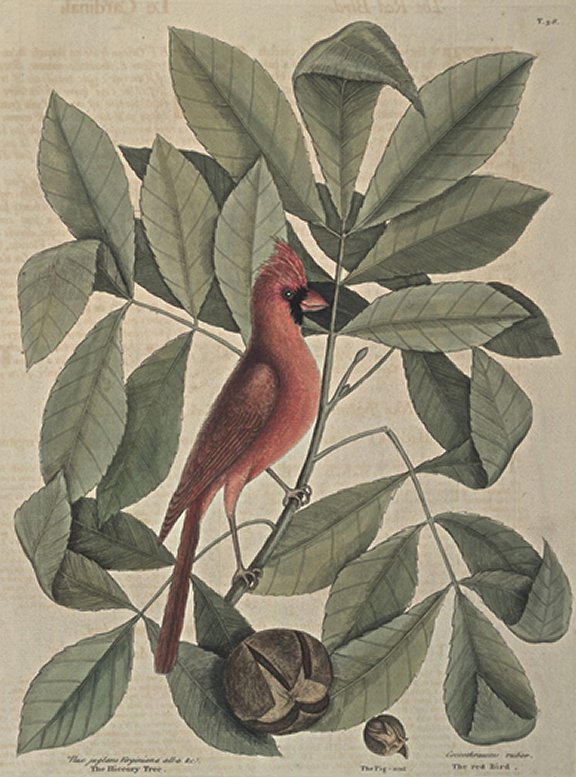Plate Number: I 38Coccothraustes Rubra: The Red Bird In Bigness it equals if not exceeds the Sky-Lark. The Bill is of a pale red, very thick and strong. A black Lift encompasses the Basis of it. The Head is adorned with a towering Crest, which it raises and falls at Pleausure. Except the Black round the Basis of the Bill, the whole Bird is scarlet, though the Back and Tail have least Lustre, being darker and of a more Cloudy red. The Hen is brown; yet has a tincture of red on her Wings, Bill and other parts. They often sing in Cages as well as the Cocks. These Birds are common in all parts of America, from New England to the Capes of Florida, and probably much more South. They are seldom seen above three or four together. They have a very great Strength with their Bill, with which they will breack the harden Grain of Maiz with much facility. It is a hardy and familiar Bird. They are frequently brought from Virginia and other parts of North America for their Beauty and agreable Singing, they having some Notes not unlike our Nightingale, which in England seems to have caused its Name of the Virginia Nightingale, though in those Countries they call it the Red Bird. Nux Juglans alba Virgiensis: The Hiccory TreeThis usually a tall Tree, and oftenn grows to a large Bulk, the Body being from two to three Feet Diameter. The Leaves are serrated, narrower and sharper pointed than the Walnut, but in Manner of growing on foot-stalks, like it. The Nuts are inclosed in like manner with the Walnut, with an outer and inner Shell. In 0ctober, at which time they are ripe, the outer Shell opens and divides in Quarters, disclosing the Nut, the shell of which is thick, not easily broke but with a Hammer. The Kernel is sweet and well tasted, from which the Indians draw a wholesome and pleasant Oil, storing them up for their Winter-Provision. The Hogs and many wild Animals receive great Benefit from them. The Wood is course-grained; yet of much use for many things belonging to Agriculture. Of the Saplings or young Trees are made the best Hoops for Tobacco, Rice and Tar-Barrels: And for the Fire no Wood in the Northern parts of America is in so much Request. The Bark is deeply furrowed. Nux Juglians Caralinensis fructu minimo putamine levi: The PignutThe Branches of this Tree spread more, are smaller, and the Leaves not so broad as the Hiccory; nor is the Bark so wrinkled. The Nuts are not above one forth part so big as those of the Hiccory, having both the inner and outer shell very thin; so that they may easily be broke with one's Fingers. The kernels are sweet; but being small, and covered with a very hitter skin, makes them usuless, except for Squirrels and other Wild Creatures. Another Walnut remains to be observed, which I never saw but in Virginia and is there called the white Walnut. The Tree is usually small; the Bark and Grain of the Wood very White: The Nut is About the size or rather less than the black Walnut, of an oval form, the outermost shell being rough. |